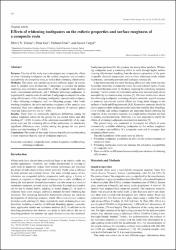Effects of whitening toothpastes on the esthetic properties and surface roughness of a composite resin
Citation
Yilmaz, M. N., Gul, P., Unal, M., & Turgut, G. (2021). Effects of whitening toothpastes on the esthetic properties and surface roughness of a composite resin. Journal of Oral Science, 21-0044.Abstract
Purpose: The aim of this study was to investigate and compare the effects
of some whitening toothpastes on the surface roughness and coloration
susceptibility of a composite resin, as well as their whitening effectiveness.
Methods: This study was carried out in two different stages. In experiment A, samples were divided into 7 subgroups to compare the surface
roughness and coloration susceptibility of the composite resin: distilled
water, conventional toothpaste, and 5 different whitening toothpastes. In
experiment B, samples were divided into 8 subgroups to compare the whitening effectiveness of the whitening toothpastes: conventional toothpaste,
5 other whitening toothpastes, and two bleaching groups. After toothbrushing simulation, the color and surface roughness of the samples were
measured. Data were subjected to one-way analysis of variance, paired
t-test and Tukey post-hoc test (α = 0.05).
Results: There were no statistically significant differences among the
surface roughness values for the groups for any period before and after
brushing (P > 0.05). In terms of the coloration susceptibility of the composite resin and the whitening effects of the toothpastes, no statistically
significant differences were evident among the groups for any period
before and after brushing (P > 0.05).
Conclusion: The results of this study indicate that effective toothbrushing
is more important than the type of toothpaste employed.
















